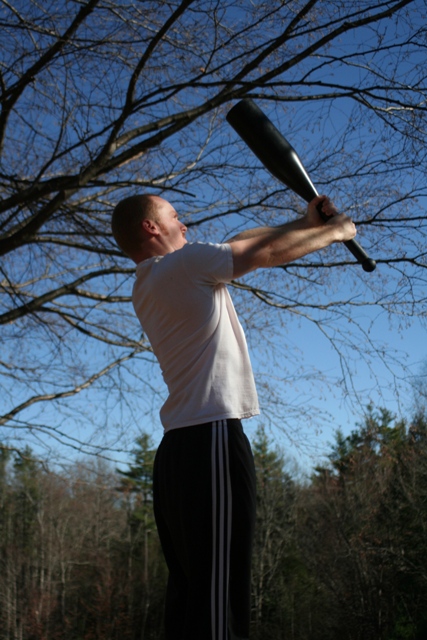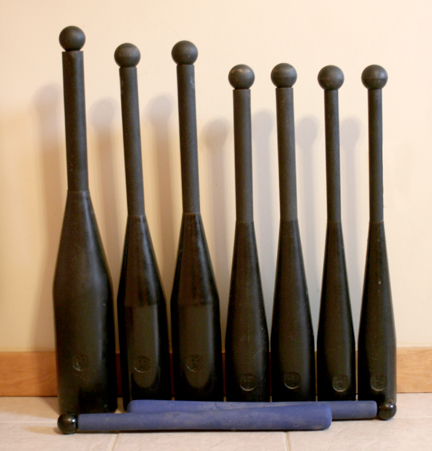Everything you ever wanted to know about clubbells – the world’s best club swinging tool for strength training.

The clubbell is a club swinging tool that is primarily used for strength and conditioning, fitness training, and athletic performance enhancement. I’ve been using clubbells regularly since 2006, and it’s about time that I give this great piece of equipment the attention it deserves. I’ve seen what they’re capable of, and to tell you the truth, I’m very impressed.
Given that clubbells are not cheap, you should probably know the whole story before making your first purchase. I know what it’s like being a first-time buyer – you’re skeptical. I was too. Back when I first learned of clubbells, I was a fresh out-of-college, soon-to-be married personal trainer with very little disposable income. Every penny counted, and I wasn’t about to blow a bunch of money on a scam product that would collect dust in my home gym. I needed to know if it would be worth the investment BEFORE I spent my hard-earned cash.
The RMAX organization makes some bold claims concerning the clubbell. Truth be told, I think some of them are way over the top, but that doesn’t mean I would discourage anyone from looking into purchasing a clubbell. It’s just important to educate yourself and understand the TRUE advantages, disadvantages, and proper applications before you pull out that credit card.
This review is meant to help you in two ways: 1) learn all about the clubbell training tool itself, and, 2) decide if it’s right for your situation. I’d also like to offer you a free gift if you do decide to invest in the clubbell.
Clubbell Review Components:
1) Learn all about the Clubbell equipment itself in the Product Review (videos): This is where you’ll get all of your product-related questions answered, including detailed information about what the clubbell is, what it’s made of, quality and design considerations, what makes it unique, and who the clubbell is best suited for (and not best suited for).
2) Determine if the Clubbell is the right training tool for you: This section will deal specifically with who can benefit from the clubbell, and who cannot. If you’re trying to make up your mind about whether the clubbell is right for YOU and your circumstances, then this section will provide you with the answers you need.
You’re about to get an inside look at what clubbells are REALLY all about. This is a long product review, as I wanted to err on the thorough side and try to cover everything. So, let’s take a detailed look at the clubbell, the world’s best club swinging tool.
Clubbell Product Review
The clubbell combines modern engineering technology with ancient principles of strength training to create an effective tool for health-first, multi-planar strength training (that’s fancy speak for “three-dimensional strength in real life”).
The advantage that the clubbell has over other weight swinging tools is in its innovation and design standards. Simply put, the clubbell has a far superior design and higher quality standards over other weight swinging tools.
The primary advantage that the clubbell has over other strength training tools is its multi-dimensional training nature, and that it can be used to improve the conditioning of a broad range of movements, instead of just muscle groups. This is not just another feature or highlight to throw in with the rest – this has major implications! We live, work, and play in three dimensions, and our training should reflect and enhance this. We are not creatures of isolation, but creatures of integration. The clubbell teaches you to integrate your body with complex movement chains that are directly applicable to real world needs. This is exactly why I have incorporated it into my training programs. The clubbell teaches you how to apply whole-body strength through a broad range of highly technical, athletic movements.
It should also be noted that with the clubbell, you can strengthen full ranges of motion, not just partial-range, limited movements (like most pushing, pulling, and twisting exercises). Not only that, but the clubbell can be very light and yet still produce significant adaptive training effects through the use of momentum. With other weight lifting tools, you’ll need a heavier implement which places unnecessary strain on the joints and connective tissues, slowly eroding them over time. Instead, the clubbell strengthens your joints through traction and shock absorption.
You’re going to learn a lot about these unique advantages and more during the “Pros and Cons” section of the product review videos. First, let’s take a look at the clubbell equipment itself…
The Complete Clubbell Product Review (Part 1)
The Complete Clubbell Product Review (Part 2)
TACFIT Clubbells vs CST Clubbells – Complete Product Review
Note: the short version of the TACFIT Clubbells vs CST Clubbells review video is this: Don’t buy TACFIT Clubbells. Buy CST Clubbells!
Clubbell Benefits to the User
You probably noticed a common theme in the review videos: versatility. I frequently mentioned that the clubbell has a very broad application and can be used for a variety of purposes. When you boil it down to its very essence, the clubbell is just an awkward, heavy object that is best used for strength training. That said, almost any goal that can be accomplished through strength training can also be accomplished with a clubbell.
There are over 140 different traditional clubbell exercises taught in the Encyclopedia of Clubbell Training. These are just the basic palette of clubbell exercises, and this covers all three planes of movement (sagittal, frontal, and transverse), and all six degrees of freedom (moving up/down, left/right, forwards/backwards, bending up/down, twisting left/right, and tilting left/right). Those 140 exercises serve as a springboard for creating combination routines and even brand new exercises, unlocking literally thousands of movement/exercise possibilities. You can use the clubbell for: straight sets, supersets, circuit sets, drop sets, pyramid training, grease-the-groove training, high intensity interval training (HIIT), high-density training, escalated-density training, combo training, hybrid training, movement-skill training, endurance training, strength-endurance training, max-strength training, and so much more. Again, the clubbell is just a tool, and you decide how you’ll use it based on your goals.
So, it should go without saying that the clubbell can serve a broad range of purposes and training goals, such as:
- Fat loss – The clubbell can be used to lose bodyfat, trim up your waist, and reveal your abs because most clubbell workouts naturally increase the strength of your metabolism and burn fat for hours after you’ve finished exercising. The clubbell is so well-suited for fat loss, that most users notice a decrease in bodyfat even when pursuing other goals.
- Muscle building – The clubbell can be used for systemic hypertrophy (building functional muscle all throughout the body). It won’t help you look like a bodybuilder, but you can build an imposing “hard-body” muscular physique – even in places you didn’t know you had muscles.
- Whole body, systemic strength and power development through full ranges of motion in sophisticated movements.
- Other fitness attribute development such as strength, endurance, power, coordination, balance, agility, etc.
- Improved joint mobility and stability, muscle flexibility, and connective tissue strength - reducing the risk of injury through pre-habilitation (aka concentrated injury prevention).
- Athletic performance enhancement for a broad range of sports and recreational activities.
- Improved grip strength, which is a proven marker for longevity.
- Improved posture during static (ie standing, sitting) and dynamic physical activity (ie running, jumping, lifting, throwing, etc.) through the 7 Key Components of Structure.
Those are the major areas of benefit. Obviously, all of the other benefits of exercise will also come along with clubbell use: higher energy levels, increased bone density, lower blood pressure and blood cholesterol numbers, improved cardiac and respiratory function, stronger metabolism, etc.
Why I Don’t Recommend These Other Similar Tools
So, now you know why I fully endorse and recommend the clubbell. Let me share with you some specific reasons why I do NOT recommend other similar tools…
- Indian Clubs – The smaller ones, though easier to maneuver around the body, are too light to create a substantial adaptive training effect for the whole body. The larger Indian clubs, though traditional, are too bulky to swing around the body during most exercises, and thus, have a very limited margin of use.
- Macebells – The macebell excels in a handful of exercises, but they are too long for versatile use, and thus, have a very limited exercise selection.
- Sledgehammers – These were never designed with exercise in mind. The awkward weight distribution of the sledgehammer makes swinging them difficult and limited to only the simplest movements (ie leverage holds and woodchoppers onto a tractor tire).
- Homemade concrete clubs and Plate-loaded versions – These are too risky to the user and surroundings, and encourage fear-reactivity during normal use. The chance of injury increases dramatically upon impact with one of these tools.
- Sand-filled or water-filled plastic and/or other bats – These are unstable tools that shift when lifted or swung, and can cause injury to user in the form of torn, strained, or pulled muscles, or even joint problems. Instability is a good quality in some training tools, but not when club swinging. Even in tightly packed tools, the weight distribution is usually unbalanced, awkward to handle, and creates unnecessary strain in the joints.
With the clubbell, you get a compact, safe tool that was designed specifically for exercise. That’s why I recommend you only invest in authentic clubbells.

John’s Collection of Clubbells
John’s Advice to Prospective Buyers
I’m not a spender. I’m a penny-pincher. I don’t spend money without thoroughly evaluating a product for myself (especially when it’s expensive). I had to personally use a friends’ clubbell for months before I even bought my own. My first purchase was a pair of mini-clubbells that I spent a year using before I was fully convinced that it would be worth the investment to upgrade. It took me over 3 years to outfit my clubbell home gym because I only buy what I need and what I’ll use (and what I can afford!).
That said, clubbells have been one of the best investments in training equipment I’ve ever made. Even four years later, they have not grown old and I still use them for most of my strength and conditioning goals almost year round. Few of my training tools have received so much use.
If you’re looking for a quality club swinging tool, then I highly recommend you invest in the clubbell.
What Clubbell Weight Should I Start With?
Use the following guidelines to choose the most appropriate starting weight.
Poor Fitness Level – No training experience, recent rehabilitation from injuries, small build
Men – Pair of 10 lb clubbells, and/or a single 20 lb clubbell
Women – Pair of 5 lb clubbells, and/or a single 15 lb clubbell
Women – Pair of 5 lb clubbells, and/or a single 15 lb clubbell
Average Fitness Level – Some training experience, healthy, moderate build
Men – Pair of 15 lb clubbells, and/or a single 25 or 35 lb clubbell
Women – Pair of 10 lb clubbells, and/or a single 20 or 25 lb clubbell
Women – Pair of 10 lb clubbells, and/or a single 20 or 25 lb clubbell
Excellent Fitness Level – High training experience, healthy, large build, athletic background
Men – Pair of 20 or 25 lb clubbells, and/or a single 35 or 45 lb clubbell
Women – Pair of 15 lb clubbells, and/or a single 25 or 35 lb clubbell
Women – Pair of 15 lb clubbells, and/or a single 25 or 35 lb clubbell
Note: Most men start with a pair of 15′s and women start with a pair of 10′s. These are clubbell weights that most trainees will not outgrow – even after years of use. If you’re still undecided, then choosing the lower weight is usually the best option.
Комментариев нет:
Отправить комментарий